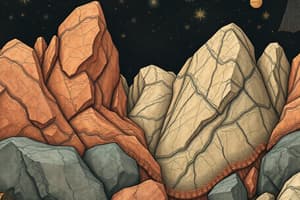Podcast
Questions and Answers
What is the main difference between intrusive and extrusive igneous rocks?
What is the main difference between intrusive and extrusive igneous rocks?
- Intrusive rocks are rich in iron and magnesium, while extrusive rocks are not
- Intrusive rocks cool rapidly, while extrusive rocks cool slowly
- Intrusive rocks have large, visible crystal formations, while extrusive rocks have invisible crystal structures (correct)
- Intrusive rocks form on the Earth's surface, while extrusive rocks form within the Earth's crust
What are some common uses of granite, an intrusive igneous rock?
What are some common uses of granite, an intrusive igneous rock?
- Producing organic sedimentary rocks
- Creating soil and sand for construction
- Forming volcanic islands and ocean floors
- Making kitchen counters and floor tiles (correct)
What process leads to the formation of sedimentary rocks?
What process leads to the formation of sedimentary rocks?
- Evaporation of sea water
- Solidification of magma
- Rapid cooling of molten lava
- Lithification of sediments (correct)
Which type of rock is limestone, and how is it formed?
Which type of rock is limestone, and how is it formed?
How are clastic sedimentary rocks like sandstone formed?
How are clastic sedimentary rocks like sandstone formed?
What type of rock is marble?
What type of rock is marble?
Under what conditions is contact metamorphism typically formed?
Under what conditions is contact metamorphism typically formed?
What distinguishes foliated metamorphic rocks from unfoliated ones?
What distinguishes foliated metamorphic rocks from unfoliated ones?
Which type of metamorphism occurs along fault lines where continental plates rub against each other?
Which type of metamorphism occurs along fault lines where continental plates rub against each other?
What is the characteristic type of metamorphism at convergent tectonic margins?
What is the characteristic type of metamorphism at convergent tectonic margins?
What are igneous rocks defined as?
What are igneous rocks defined as?
What is the difference between magma and lava?
What is the difference between magma and lava?
How do sedimentary rocks differ from igneous rocks?
How do sedimentary rocks differ from igneous rocks?
What is the process that leads to the formation of metamorphic rocks?
What is the process that leads to the formation of metamorphic rocks?
How do magma and lava contribute to the formation of igneous rocks?
How do magma and lava contribute to the formation of igneous rocks?
Flashcards
Igneous rocks: intrusive vs. extrusive
Igneous rocks: intrusive vs. extrusive
Intrusive rocks have large, visible crystal formations, while extrusive rocks have invisible crystal structures
Uses of granite?
Uses of granite?
Making kitchen counters and floor tiles
Sedimentary rock formation
Sedimentary rock formation
Lithification of sediments
What type of rock is limestone?
What type of rock is limestone?
Signup and view all the flashcards
How is sandstone formed?
How is sandstone formed?
Signup and view all the flashcards
What type of rock is marble?
What type of rock is marble?
Signup and view all the flashcards
Contact metamorphism conditions
Contact metamorphism conditions
Signup and view all the flashcards
Foliated vs. Unfoliated
Foliated vs. Unfoliated
Signup and view all the flashcards
Metamorphism along fault lines
Metamorphism along fault lines
Signup and view all the flashcards
Metamorphism at convergent tectonic margins
Metamorphism at convergent tectonic margins
Signup and view all the flashcards
Igneous rocks
Igneous rocks
Signup and view all the flashcards
Magma vs. Lava
Magma vs. Lava
Signup and view all the flashcards
How do sedimentary rocks differ from igneous rocks?
How do sedimentary rocks differ from igneous rocks?
Signup and view all the flashcards
Metamorphic Rocks
Metamorphic Rocks
Signup and view all the flashcards
Magma and lava role in igneous rocks?
Magma and lava role in igneous rocks?
Signup and view all the flashcards
Study Notes
Igneous Rocks
- Intrusive igneous rocks form below the Earth's surface, whereas extrusive igneous rocks form above the Earth's surface.
- Granite is an example of an intrusive igneous rock, commonly used in construction, countertops, and monuments.
Sedimentary Rocks
- Sedimentary rocks are formed through the process of lithification, where sediments are compressed and cemented together.
- Limestone is a type of sedimentary rock formed from the accumulation of calcium carbonate from fossilized marine life.
- Clastic sedimentary rocks, such as sandstone, are formed from the cementation of clastic sediments like sand, silt, and clay.
Metamorphic Rocks
- Marble is a type of metamorphic rock formed from the metamorphism of limestone or dolostone.
- Contact metamorphism typically occurs when magma intrudes into surrounding rocks, causing changes in temperature and pressure.
- Foliated metamorphic rocks, such as slate and gneiss, exhibit layered or banded structures, distinguishing them from unfoliated metamorphic rocks like marble.
- Dynamic metamorphism occurs along fault lines where continental plates rub against each other, resulting in intense pressure and heat.
- Regional metamorphism is characteristic of convergent tectonic margins, where two plates collide, causing intense heat and pressure.
Rock Formation Processes
- Igneous rocks are defined as rocks formed from the cooling and solidification of magma or lava.
- Magma is molten rock beneath the Earth's surface, while lava is molten rock that has erupted onto the Earth's surface.
- Sedimentary rocks differ from igneous rocks in that they are formed from the accumulation and compression of sediments, rather than from the cooling of magma.
- Metamorphic rocks are formed through the process of metamorphism, where existing rocks are transformed by heat, pressure, and chemical reactions.
Studying That Suits You
Use AI to generate personalized quizzes and flashcards to suit your learning preferences.




